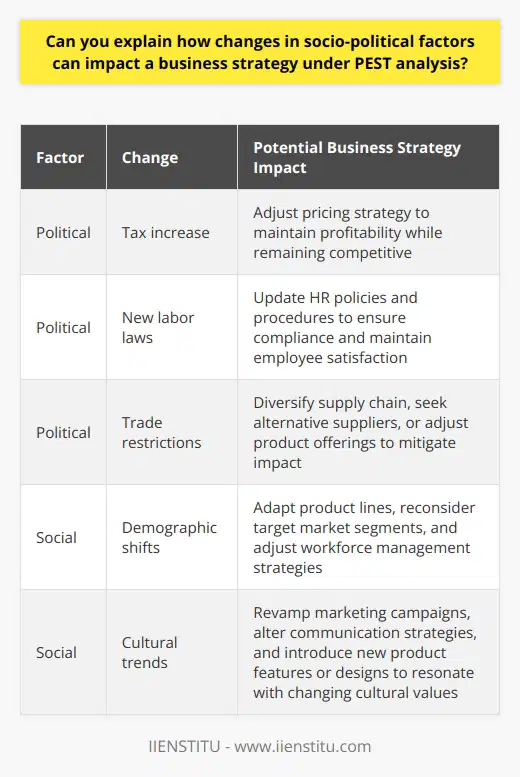
The contemporary business landscape is characterized by volatility, uncertainty, complexity, and ambiguity. These elements compel business leaders and strategists to employ comprehensive analytical tools for navigating their strategic decisions. Amidst such tools, PEST Analysis stands out as a profoundly effective framework designed to dissect the Business Environment Analysis into political, economic, social, and technological segments. This article explores the essence of PEST Analysis, illuminates its integration into Strategic Business Insights, and emphasizes its role in meticulous Market Research and Business Strategy.
🔊 Ready for an auditory reading experience? Just click the 'Play' button right below this text and immerse yourself in our captivating audio version. Ideal for those who prefer listening to stories, or for times when you're multitasking. Engage with our content effortlessly - one simple click is all it takes to transform your reading into listening!
Explanation of PEST Analysis
Definition and Purpose
PEST Analysis is an acronym for Political, Economic, Social, and Technological analysis, a strategic framework used for understanding market growth or decline, business position, potential, and direction for operations. Through meticulous examination of these external factors, organizations can better grasp the broader landscape in which they operate. The primary purpose of PEST Analysis is to identify the external forces that might affect business performance and to align strategies accordingly.
Importance in Strategic Planning
Strategic planning is crucial for the sustainability and growth of any enterprise. PEST Analysis plays a significant role in such planning by providing a clear-cut view of the external environment. By understanding these diverse external conditions, businesses are better positioned to anticipate future trends and mitigate potential threats. Besides, it is an invaluable tool for Competitive Analysis, allowing businesses to gain a competitive edge by strategizing based on informed forecasts.
Outlining the Benefits of PEST Analysis for Business Strategy
Identifying Market Opportunities and Threats
One of the quintessential benefits of PEST Analysis is the capacity to discern potential opportunities and threats in the market. By examining these dimensions, companies can exploit emerging trends and erect barriers against adverse conditions. This level of insight is fundamental to securing a company’s position within the marketplace.
Enhancing the Decision-Making Process
PEST Analysis also aids in refining the decision-making process by providing a structured approach. Leaders can make more informed decisions by taking into account the multifaceted external factors that are likely to impact their business operations. With such a comprehensive evaluation, strategies are formulated not merely on the basis of intuition but on solid, evidence-based insights.
The Components of PEST Analysis
Understanding the nuances of each component within the PEST framework is imperative for a robust analysis of the business environment. These factors, in tandem, can inform strategic choices and highlight potential avenues for growth or the need for caution.
Political Factors and Their Impact on Business
Government Policies and Regulations
Political factors comprise government policies, regulatory frameworks, and legal issues that can significantly impact businesses. Government interventions in the economy such as tax policies, trade restrictions, and labor laws can either impede or enhance business operations. Awareness and adaptation to these political climates are critical to avoid legal ramifications and to leverage governmental support for business success.
Political Stability and Risks
Political stability is another crucial aspect of the political dimension; a stable political climate is conducive to business activities, whereas political turmoil can hamper market operations. For this reason, multinational companies often conduct rigorous risk assessments before entering new markets to assess the potential for political unrest or regulatory changes.
Economic Factors Affecting Business Strategy
Economic Growth and Cycles
The economic environment encompasses factors such as growth rates, inflation, and unemployment rates that can have profound effects on businesses. Economic cycles, from booms to recessions, influence consumer spending and investment. Business strategies must, therefore, be responsive to these economic indicators to buffer against downturns and leverage periods of growth.
Inflation, Interest Rates, and Exchange Rates
Other economic factors such as inflation, interest rates, and exchange rates also play a significant part in determining the cost of capital and demand for products across different markets. Inflation can erode purchasing power; high-interest rates can increase borrowing costs, and volatile exchange rates can affect export competitiveness.
Social Factors and Market Research
Demographic Changes and Consumer Trends
Social trends like demographic shifts, lifestyle changes, and consumer behaviors are pivotal considerations in Market Research. An aging population, for example, may suggest a higher demand for healthcare services, while shifts in consumer behavior could signal the need to adapt marketing strategies or product offerings.
Cultural Norms and Workforce Attitudes
Cultural norms and values, along with local workforce attitudes, can shape business practices and consumer preferences. Companies eager to succeed in diverse markets must be cognizant of cultural differences to position their products effectively and to harness a motivated and productive workforce.
Technological Factors in Competitive Analysis
Technological Advancements and Innovation
Technology is a formidable force in shaping competitive landscapes. Technological advancements can lead to innovation and disruption, thus affecting market dynamics and necessitating businesses to adapt swiftly. PEST Analysis assists in pinpointing which technological trends may influence business operations and customer expectations.
Intellectual Property Issues and Automation
Challenges such as intellectual property rights and the increasing pace of automation also form part of the technological analysis. Safeguarding intellectual property is imperative in a digitally connected world, while automation can lead to efficiency gains or labor market disruptions.
Application of PEST Analysis in Different Business Contexts
Practical application of this analysis tool across various business scenarios elucidates its versatility and adaptability. Here we provide a few illustrative examples of how PEST analysis can be used for diverse strategic insights.
Transformative Techniques For Effective Problem-solving And Personal Growth
Collaborative Planning, Forecasting, And Replenishment Benefits İn Supply Chain Management
Case Studies Illustrating Strategic Insights Gained
Industry-Specific Examples
Each industry faces its unique permutation of PEST factors. For instance, the pharmaceutical industry is highly susceptible to political influences in terms of regulations, while the automotive sector is deeply affected by economic factors such as consumer purchasing power and technological advancements in electric vehicles.
Success Stories and Lessons Learned
Business success stories often point to strategic foresight gained through PEST Analysis. Companies that anticipated regulatory changes or socio-cultural shifts were able to pivot their strategies effectively. Conversely, businesses that misconstrued their environmental analysis have provided cautionary tales underscoring the need for meticulous evaluation of PEST elements.
Critique and Limitations of PEST Analysis
Static vs. Dynamic Environment Considerations
While PEST Analysis provides a snapshot of the external environment, it is often critiqued for its static nature. The rapid pace of change necessitates a more dynamic model of analysis. Hence, it is commonly recommended to conduct PEST Analysis periodically and integrate findings with other dynamic analytical frameworks.
Need for Supplementary Analysis Tools
PEST Analysis is a starting point, and its insights are best complemented with other analysis tools like SWOT (Strengths, Weaknesses, Opportunities, Threats) or Porter’s Five Forces for a more nuanced strategic perspective. The interplay between various strategic models offers a more comprehensive view enabling businesses to craft robust strategies.
Conducting Effective PEST Analysis
To conduct an effective PEST analysis, a systematic and thorough approach is necessary. This section outlines a step-by-step guide and describes how PEST can be woven into larger business strategies.
Step-by-Step Guide to Performing a PEST Analysis
Data Collection and Sources
Commencing with the data collection process, businesses must gather relevant information from credible sources, including industry reports, economic forecasts, demographic studies, and technological trend analyses. Public government databases and paid market research reports are typical starting points for assembling the required data.
Analyzing and Interpreting Data
Once data is gathered, the next step is to critically analyze and interpret this information concerning the business context. Researchers must discern which factors are most likely to impact business operations and strategy and then distill these findings into actionable insights.
Integrating PEST Analysis into Overall Business Strategy
Aligning PEST with Company Vision and Objectives
PEST Analysis must be aligned with the company’s vision and objectives to ensure that actionable strategies are coherent with the broader business goals. The insights derived from a PEST Analysis should inform strategic decisions in marketing, and product development, and influence long-term planning.
Adaptability to Changing Environmental Factors
The continuous transformation of external factors mandates that businesses remain nimble. Companies need to regularly revisit their PEST Analysis to adapt their strategies in alignment with evolving political, economic, social, and technological landscapes.
The Future of PEST Analysis in Business
As business environments and technologies evolve, so too must the tools used to analyze and navigate these spaces. PEST Analysis will continue to evolve, reflecting the ongoing changes in the global business context.
Anticipating Changes in the Business Landscape
Incorporating Globalization and Cross-Border Dynamics
Globalization and cross-border interactions are intensifying, which means that PEST Analysis must increasingly consider international implications. Changes in one region can have ripple effects globally, making it vital for businesses to incorporate a global perspective into their analysis.
Environmental Sustainability Considerations
Sustainability has become a critical concern, not just from a social responsibility standpoint but also as a business imperative. Adapting PEST Analysis to include environmental factors (sometimes expanding it to PESTLE to include Legal and Environmental) reflects an acknowledgment of the need to consider ecological impacts in business strategies.
Adapting PEST Analysis for Technological Evolution
Digitalization and the Role of Big Data
The advent of big data and digitalization offers new dimensions for PEST Analysis. With more information available than ever, analyzing these vast data sets using artificial intelligence and machine learning can bring more precision to predicting and understanding external factors.
AI and Automation in Market Research
AI and automation are significantly enhancing the scope and accuracy of Market Research. PEST Analysis can benefit from these technologies to automate the collection and processing of relevant data, thereby enabling more sophisticated and timely environmental analyses.
Conclusion
A thorough PEST Analysis is indispensable for any business seeking to navigate the increasingly complex and globally interrelated markets of today. Its systematic approach provides valuable insights into the external factors that can greatly impact business efficacy and strategic direction.
Recap of the Value of PEST Analysis in Strategic Business Decision-Making
Summary of Key Insights
In summary, PEST Analysis aids in capturing valuable insights into the political, economic, social, and technological factors that can influence strategic business choices. It is a critical evaluator of the potential threats and opportunities that ultimately shape a firm's ability to succeed and grow.
Affirmation of PEST Analysis as an Essential Tool
In the realm of business strategies and environmental analysis, PEST Analysis has been reaffirmed as an essential tool. Its application bolsters decisions, enables the capitalization of opportunities, and aids in the fortification against market volatilities.
Final Thoughts on Navigating Business Environments
Embracing Complexity and Uncertainty
As businesses forge ahead, the need to embrace complexity and uncertainty becomes more apparent. PEST Analysis is part of the strategic artillery that can help leaders navigate these challenges with greater confidence.
Continuous Learning and Strategic Flexibility
Finally, organizations must commit to continuous learning and maintain strategic flexibility to keep pace with the rapid changes in external business environments. PEST Analysis, coupled with lifelong learning opportunities such as an online MBA course or a problem solving course free of charge, can significantly enhance strategic agility.
Frequently Asked Questions
What are the main components of PEST analysis in strategic business insights?
Understanding PEST Analysis
PEST analysis stands as a crucial strategic tool. It helps businesses understand market growth or decline. This tool also identifies potential and direction for operations. By analyzing various external factors, companies can prepare for possible challenges.
Components of PEST Analysis
The acronym PEST represents four elements, namely:
- Political
- Economic
- Social
- Technological
Each of these components examines different external factors.
Political Factors
Political elements often involve government policy. These can directly affect business operations. They include tax policies, labor laws, and trade restrictions. Also, political stability plays a key role here. Companies must assess their impact. Insight into these factors aids risk management.
Economic Factors
Economic elements assess the market economy's performance. Interest rates, inflation, and employment levels come under this. These factors dictate consumer purchasing power. They also influence the cost of capital for businesses. Hence, companies monitor them closely. Understanding these helps forecast market trends.
Social Factors
Social elements explore society's trends and behaviors. They reflect demographics, cultural norms, and population growth rates. Lifestyle changes and education levels are part here too. These aspects impact demand for products and services. Companies must adapt to these societal shifts. This ensures relevance and consumer engagement.
Technological Factors
Technological elements showcase innovation in technology. These aspects include automation, research and development, and technological awareness. They impact how an organization operates. They also affect product development and market reach. Staying ahead in technology offers competitive advantages.
Significance in Strategy
Businesses must integrate PEST analysis into strategic planning. It provides a comprehensive view of the macro-environment. It highlights potential threats and opportunities. Each factor needs careful evaluation. This understanding shapes long-term strategy. It aligns business objectives with environmental realities.
In sum, PEST analysis serves as an essential tool. It grants foresight and prepares businesses for external shifts. It supports strategic decision-making. Companies that utilize it can often navigate complexities better. Strategic insights from PEST encourage proactive rather than reactive planning.

How does PEST analysis contribute to the strategic planning process in businesses?
Understanding PEST Analysis
In strategic planning, businesses face external pressures. These forces shape opportunities and threats. PEST analysis provides a comprehensive tool for scanning these external environments. PEST stands for Political, Economic, Social, and Technological factors.
Political Factors Influence Strategy
Political elements define the regulatory framework. They include government policies, trade agreements, and stability. Companies use PEST to anticipate political shifts. These insights lead to proactive strategy adjustments. They guard against regulatory risks.
Economic Factors Drive Business Decisions
Economic conditions sway market dynamics. These include inflation, exchange rates, and economic growth. PEST analysis illuminates these economic indicators. Businesses then align strategies with economic cycles.
Social Factors Affect Consumer Behavior
Social trends shape consumer preferences. These trends involve demographics, lifestyle changes, and cultural shifts. With PEST, firms track social changes. They adapt offerings to match evolving consumer needs.
Technological Advancements Prompt Innovation
Technological breakthroughs redefine industries. PEST analysis scans tech trends. Firms leverage this data. They innovate products and streamline operations.
PEST and Strategic Planning Synergy
PEST analysis contributes to strategic planning through several avenues. These foster-informed decision-making. They support long-term success.
Identifying Opportunities and Threats
PEST aids in spotting upcoming trends. Firms identify market opportunities early. They also pinpoint potential threats. This leads to timely and informed strategy crafting.
Shaping Market Entry Strategies
Businesses consider PEST before entering new markets. They understand the local context. This ensures adapted and relevant market strategies.
Guiding Resource Allocation
Companies allocate resources more effectively with PEST. They base investments on external factor analyses. This optimizes outcomes.
Enabling Risk Management
PEST equips businesses to manage risks. They foresee external challenges. Strategies thus incorporate risk mitigation.
Fostering Innovation and Growth
Continuous PEST analysis inspires innovation. It keeps firms aligned with external progress. This paves the way for growth.
PEST analysis constitutes a strategic planning cornerstone. It turns external landscapes into strategic insights. Businesses then navigate complexities with confidence. This strategic framework bolsters both resilience and competitiveness.

Can you explain how changes in socio-political factors can impact a business strategy under PEST analysis?
Understanding PEST Analysis
PEST analysis stands for Political, Economic, Social, and Technological analysis. It is a strategic tool that businesses use to track the environment in which they operate. By assessing these four external factors, companies can plan and adapt their strategies appropriately.
Socio-Political Factors in Business Strategy
Impact of Political Factors
Political factors refer to how government policy and actions impact business operations. These factors can include tax policy, labor law, environmental regulations, trade restrictions, and political stability. A change in any of these political factors can compel businesses to adapt their strategies.
- A tax increase may affect pricing strategy.
- New labor laws often require HR policy updates.
- Trade restrictions can necessitate supply chain adjustments.
Influence of Social Factors
Social factors analyze the demographic and cultural aspects of the external environment. These include population growth rates, age distribution, career attitudes, and emphasis on safety. Changes here alter market demand and can impact:
- Product development
- Market positioning
- Brand messaging strategies
Strategy Adaptation to Political Change
Adapting to Regulatory Changes
Regulatory changes can alter the competitive landscape. Businesses might need to:
- Invest in new technologies
- Seek alternative suppliers
- Adjust their product or service offerings
Political Stability and Strategy
A shift toward instability can lead to:
- Contingency planning for disruptions
- Diversifying into more stable markets
- Protecting assets against political risk
Social Changes and Business Strategy
Demographic Shifts
Population changes require businesses to:
- Adapt their product lines
- Reconsider market segments
- Adjust their workforce management
Cultural Trends
Cultural shifts often demand:
- Revamped marketing campaigns
- Altered communication strategies
- New product features or design
The Interconnectivity of Socio-Political Factors
The interplay between social and political factors cannot be overstated. Government policies often reflect social changes, while societal trends can influence political agendas. A holistic view is crucial when aligning business strategy with these external factors.
PEST analysis remains an essential tool. Understanding the dynamic socio-political landscape enables businesses to remain agile and competitive. As such components evolve, strategy must follow suit, ensuring a business rides the waves of change rather than being swept away by them.



